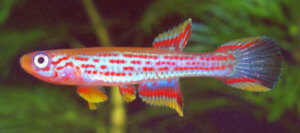Aphyosemion hanneloreae hanneloreae Radda & Pürzl 1985

Wild
male collected at Malinga, Gabon.
Photo
courtesy of Ed Pürzl.
Aphyosemion hanneloreae hanneloreae Radda & Pürzl 1985

Wild
male collected at Malinga, Gabon.
Photo
courtesy of Ed Pürzl.
| Meaning of Name |
After Hannelore Pürzl, the wife of Eduard Pürzl. | ||||||||||||
| First Description |
Radda A.C. & Pürzl E 1985. Zwei Formen der Gattung Aphyosemion aus Süd-Gabun. Aquaria 32: 157-160, 3 figures. | ||||||||||||
| Size |
4 cm (Radda & Pürzl 1987) | ||||||||||||
| Meristics |
D = 11-12, A = 14-15, D/A = +5-6, ll = 30-31(+5) (Radda & Pürzl 1985) | ||||||||||||
| Karyotype |
| ||||||||||||
| Sub-Genus |
Aphyosemion | ||||||||||||
| Group |
hofmanni | ||||||||||||
| Synonyms |
None | ||||||||||||
Populations
|
GEB 94 / 19 -
GJS 00 / 14 - Malinga.
| ||||||||||||
| Type Locality |
Malinga, in the Ngounié province, southern Gabon. This area is close to the border with Congo. GHP 85 / 11. | ||||||||||||
| Distribution |
The central area of the Du Chaillu mountains of southern Gabon. They may in future collections be found in Congo. | ||||||||||||
| Habitat |
Given as small rivulets in rainforest swamps. The type locality was described as being a marshy area belonging to the Nyanga River drainage at an elevation of 400 metres above sea level. Mogens Juhl sent me an E-mail stating that he collected this sp. in abundance at GJS 00/14 - Malinga. Water temperature was 21·1 C, pH 5·9 and conductivity 1 microseimens. This location had a depth of only 2 cm. Also found were many small barbs and a new (?) Ctenopoma from the Ct.nanum-complex. | ||||||||||||
| Distinguishing Characteristics | Dorsal & anal fins show wide marginal (yellow) & submarginal (red) bands. | ||||||||||||
| Colour/Pattern Variability | Probably low. | ||||||||||||
| History |
Discovered by Ed Pürzl & Otto Hofmann in June 1985 close to Malinga in the centre of the Du Chaillu Massif. This collection code was GHP 85 / 11. | ||||||||||||
| Breeding Notes |
BKA newsletter No. 399, December 1998 has an
article by Angel Cabrera on breeding GEB 94 / 20. Fish needed to be
maintained in clean water & not crowded or they became sensitive
to velvet. He did not use salt with these fish. Water temperature was
20-22°C, pH 6-6·5, GH 2. Natural light was used. | ||||||||||||
| Diameter of Egg | |||||||||||||
| Remarks |
It may be that this species is territorial in nature as males can be aggresive to each other. |